YAMAHA XVS125 2000 Owner's Manual
Manufacturer: YAMAHA, Model Year: 2000, Model line: XVS125, Model: YAMAHA XVS125 2000Pages: 86, PDF Size: 3.07 MB
Page 21 of 86
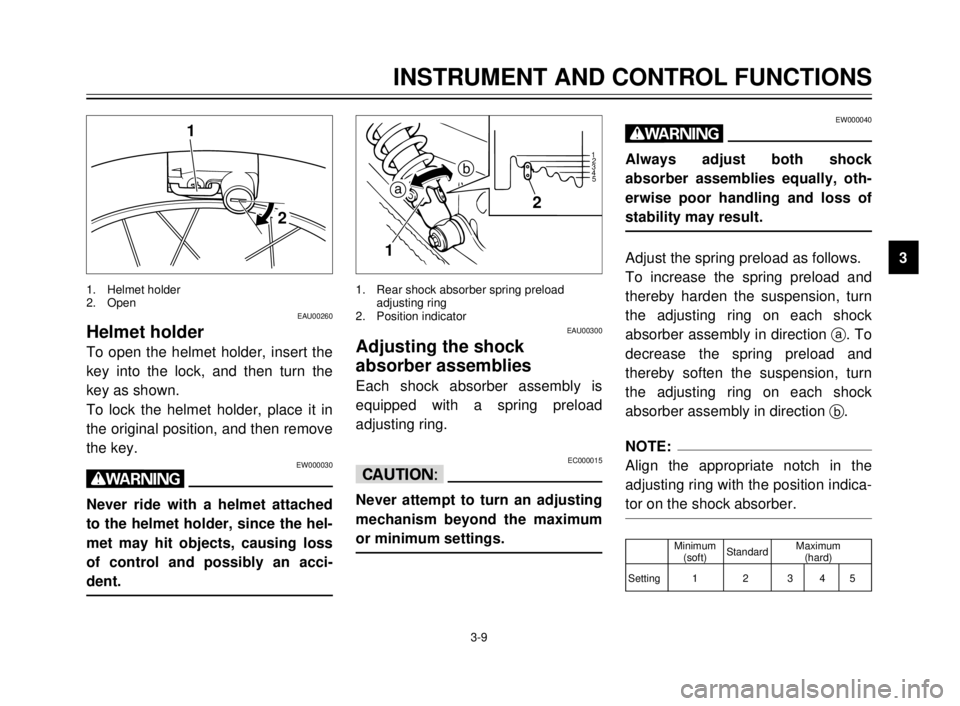
INSTRUMENT AND CONTROL FUNCTIONS
3
3-9
EAU00260
Helmet holder
To open the helmet holder, insert the
key into the lock, and then turn the
key as shown.
To lock the helmet holder, place it in
the original position, and then remove
the key.
EW000030
w
Never ride with a helmet attached
to the helmet holder, since the hel-
met may hit objects, causing loss
of control and possibly an acci-
dent.
1. Helmet holder
2. Open
1
2
EW000040
w
Always adjust both shock
absorber assemblies equally, oth-
erwise poor handling and loss of
stability may result.
Adjust the spring preload as follows.
To increase the spring preload and
thereby harden the suspension, turn
the adjusting ring on each shock
absorber assembly in direction a. To
decrease the spring preload and
thereby soften the suspension, turn
the adjusting ring on each shock
absorber assembly in direction b.
NOTE:
Align the appropriate notch in the
adjusting ring with the position indica-
tor on the shock absorber.
EAU00300
Adjusting the shock
absorber assemblies
Each shock absorber assembly is
equipped with a spring preload
adjusting ring.
EC000015
cC
Never attempt to turn an adjusting
mechanism beyond the maximum
or minimum settings.
1. Rear shock absorber spring preload
adjusting ring
2. Position indicator
1
2
3
4
5
b
a
2
1
Minimum
StandardMaximum(soft) (hard)
Setting 1 2 3 4 5
5JX-9-E0 4/9/0 4:11 AM Page 19
Page 22 of 86

3-10
INSTRUMENT AND CONTROL FUNCTIONS
3
EAU00330
Sidestand
The sidestand is located on the left
side of the frame. Raise the side-
stand or lower it with your foot while
holding the motorcycle upright.
NOTE:
The built-in sidestand switch is part of
the ignition circuit cut-off system,
which cuts the ignition in certain situ-
ations. (See further down for an
explanation of the ignition circuit cut-
off system.)
EW000044
w
The motorcycle must not be ridden
with the sidestand down, or if the
sidestand cannot be properly
moved up (or does not stay up),
otherwise the sidestand could con-
tact the ground and distract the
operator, resulting in a possible
loss of control. Yamaha’s ignition
circuit cut-off system has been
designed to assist the operator in
fulfilling the responsibility of rais-
ing the sidestand before starting
off. Therefore, check this system
regularly as described below and
have a Yamaha dealer repair it if it
does not function properly.
EAU00331
Ignition circuit cut-off
system
The ignition circuit cut-off system
(comprising the sidestand switch,
clutch switch and neutral switch) has
the following functions.
8It prevents starting when the
transmission is in gear and the
sidestand is up, but the clutch
lever is not pulled.
8It prevents starting when the
transmission is in gear and the
clutch lever is pulled, but the
sidestand is still down.
8It cuts the running engine when
the sidestand is moved down.
Periodically check the operation of
the ignition circuit cut-off system
according to the following procedure.
EW000045
w
If a malfunction is noted, have a
Yamaha dealer check the system
before riding.
5JX-9-E0 4/9/0 4:11 AM Page 20
Page 23 of 86
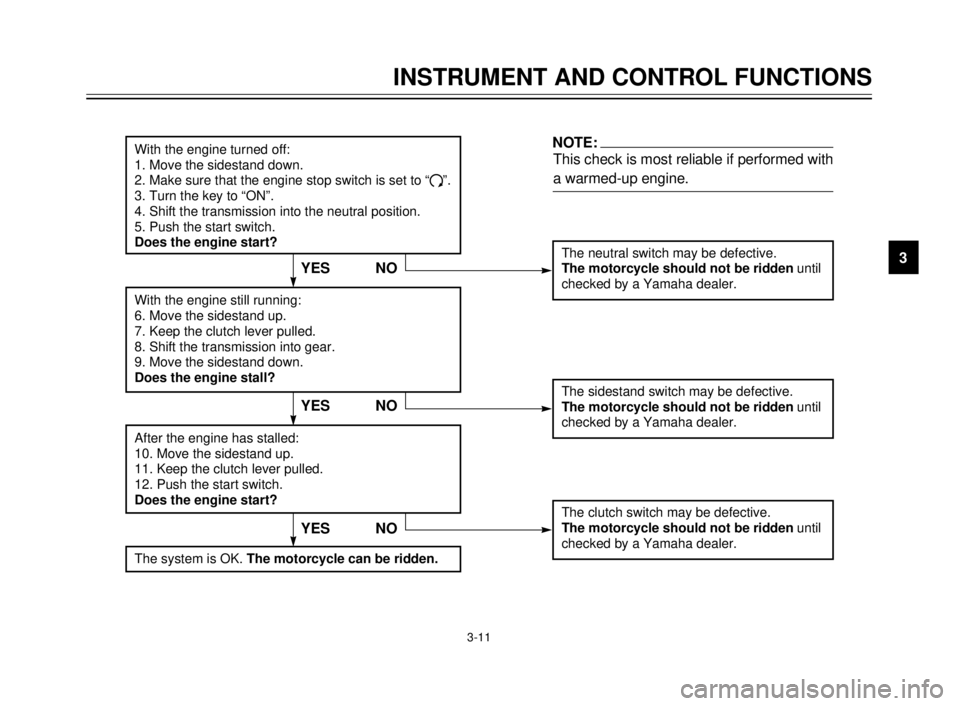
INSTRUMENT AND CONTROL FUNCTIONS
3
3-11
With the engine turned off:
1. Move the sidestand down.
2. Make sure that the engine stop switch is set to Ò
#Ó.
3. Turn the key to ÒONÓ.
4. Shift the transmission into the neutral position.
5. Push the start switch.
Does the engine start?
The neutral switch may be defective.
The motorcycle should not be ridden until
checked by a Yamaha dealer.
With the engine still running:
6. Move the sidestand up.
7. Keep the clutch lever pulled.
8. Shift the transmission into gear.
9. Move the sidestand down.
Does the engine stall?
After the engine has stalled:
10. Move the sidestand up.
11. Keep the clutch lever pulled.
12. Push the start switch.
Does the engine start?
The sidestand switch may be defective.
The motorcycle should not be ridden until
checked by a Yamaha dealer.
The clutch switch may be defective.
The motorcycle should not be ridden until
checked by a Yamaha dealer.
NO
NOTE:
This check is most reliable if performed with
a warmed-up engine.
YES
YES NO
The system is OK. The motorcycle can be ridden.
YES NO
5JX-9-E0 4/9/0 4:11 AM Page 21
Page 24 of 86

EAU01114
PRE-OPERATION CHECKS
1
2
3
4
5
6
7
8
9
4-1
The condition of a vehicle is the ownerís responsibility. Vital components can start to deteriorate quickly and unexpect-
edly, even if the vehicle remains unused (for example, as a result of exposure to the elements). Any damage, fluid leak-
age or loss of tire air pressure could have serious consequences. Therefore, it is very important, in addition to a thor-
ough visual inspection, to check the following points before each ride.
EAU00340*
Pre-operation check list
ITEM CHECKS PAGE
Front brake9Check operation, free play, fluid level and vehicle for fluid leakage.
3-5, 6-20–6-21, 6-23–6-25
9Add DOT 4 brake fluid if necessary.
Rear brake9Check operation and free play.
3-6, 6-21–6-23
9Adjust if necessary.
Clutch9Check operation and free play.
3-5, 6-19–6-20
9Adjust if necessary.
Throttle grip and housing9Check smooth operation.
6-15
9Lubricate.
Engine oil9Check oil level.
6-9–6-10
9Add oil if necessary.
Drive chain9Check chain slack and condition.
6-25–6-27
9Adjust if necessary.
Wheels and tires9Check tire pressure, wear, damage and spoke tightness.
6-16–6-19
9Tighten spokes if necessary.
Control and meter cable9Check smooth operation.
6-28
9Lubricate if necessary.
Brake and shift pedal shafts9Check smooth operation.
6-28
9Lubricate if necessary.
Brake and clutch lever pivots9Check smooth operation.
6-29
9Lubricate if necessary.
5JX-9-E0 4/9/0 4:11 AM Page 22
Page 25 of 86

PRE-OPERATION CHECKS
1
2
3
4
5
6
7
8
9
4-2 ITEM CHECKS PAGE
Sidestand pivot9Check smooth operation.
6-29
9Lubricate if necessary.
Chassis fasteners9Make sure that all nuts, bolts, and screws are properly tightened.
—
9Tighten if necessary.
Fuel tank9Check fuel level.
3-6–3-7
9Add fuel if necessary.
Lights, signals and
9Check proper operation. 3-3–3-4, 6-34–6-37
switches
NOTE:
Pre-operation checks should be made each time the motorcycle is used. Such an inspection can be accomplished in a
very short time; and the added safety it assures is more than worth the time involved.
w
If any item in the Pre-operation check list is not working properly, have it inspected and repaired before operat-
ing the motorcycle.
5JX-9-E0 4/9/0 4:11 AM Page 23
Page 26 of 86
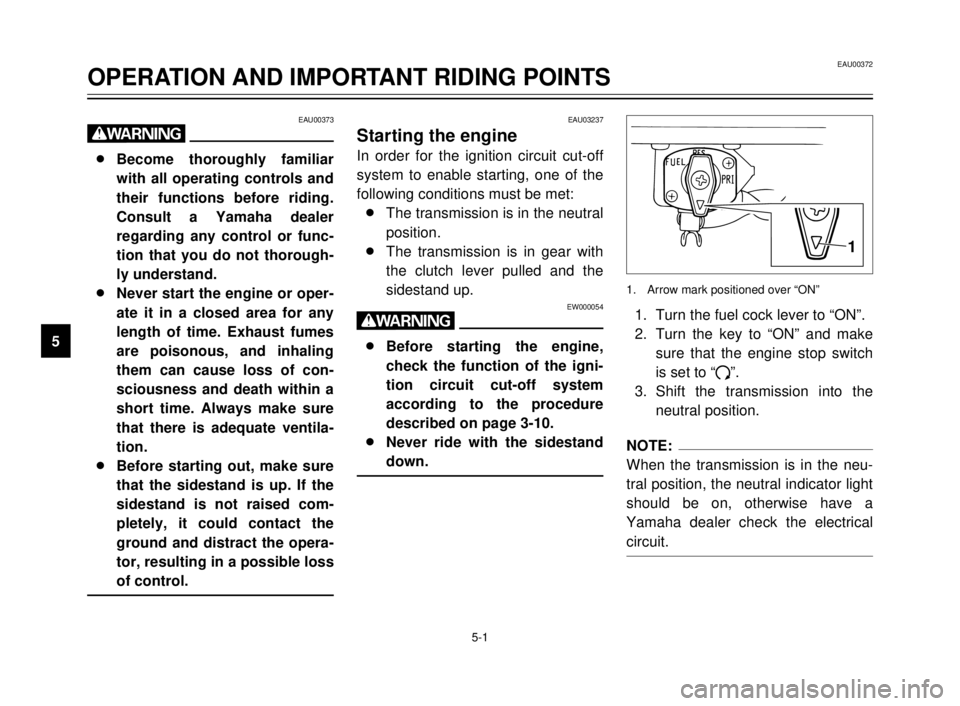
5-1
EAU00372
OPERATION AND IMPORTANT RIDING POINTS
1
2
3
4
5
6
7
8
9
EAU00373
w
8Become thoroughly familiar
with all operating controls and
their functions before riding.
Consult a Yamaha dealer
regarding any control or func-
tion that you do not thorough-
ly understand.
8Never start the engine or oper-
ate it in a closed area for any
length of time. Exhaust fumes
are poisonous, and inhaling
them can cause loss of con-
sciousness and death within a
short time. Always make sure
that there is adequate ventila-
tion.
8Before starting out, make sure
that the sidestand is up. If the
sidestand is not raised com-
pletely, it could contact the
ground and distract the opera-
tor, resulting in a possible loss
of control.
EAU03237
Starting the engine
In order for the ignition circuit cut-off
system to enable starting, one of the
following conditions must be met:
8The transmission is in the neutral
position.
8The transmission is in gear with
the clutch lever pulled and the
sidestand up.
EW000054
w
8Before starting the engine,
check the function of the igni-
tion circuit cut-off system
according to the procedure
described on page 3-10.
8Never ride with the sidestand
down.
1. Turn the fuel cock lever to “ON”.
2. Turn the key to “ON” and make
sure that the engine stop switch
is set to “#”.
3. Shift the transmission into the
neutral position.
NOTE:
When the transmission is in the neu-
tral position, the neutral indicator light
should be on, otherwise have a
Yamaha dealer check the electrical
circuit.
1. Arrow mark positioned over “ON”
1
5JX-9-E0 4/9/0 4:11 AM Page 24
Page 27 of 86
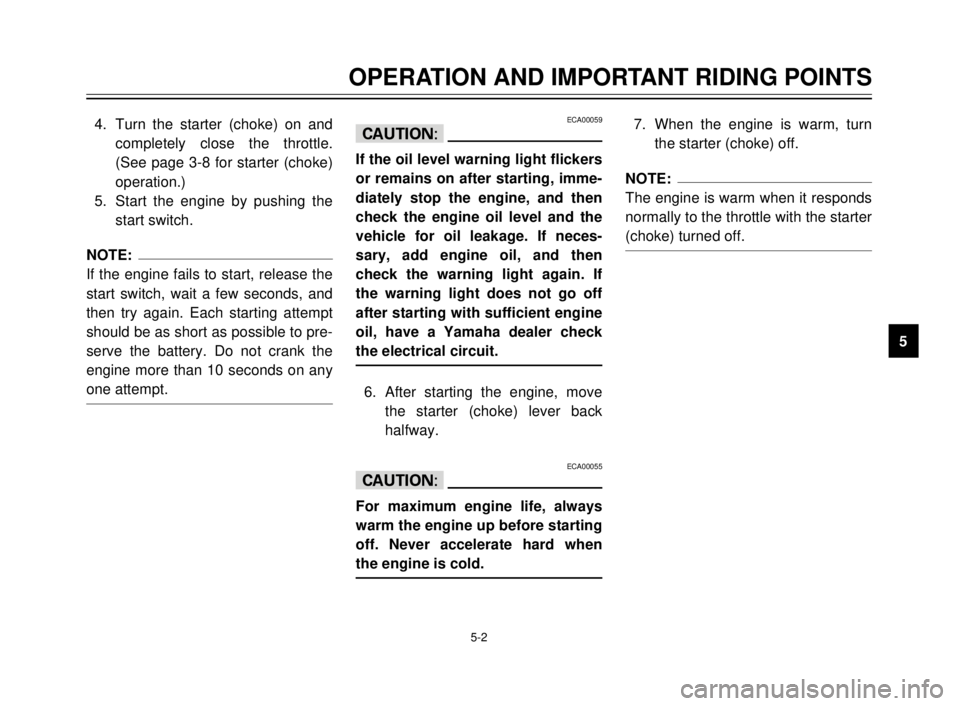
OPERATION AND IMPORTANT RIDING POINTS
1
2
3
4
5
6
7
8
9
5-2
4. Turn the starter (choke) on and
completely close the throttle.
(See page 3-8 for starter (choke)
operation.)
5. Start the engine by pushing the
start switch.
NOTE:
If the engine fails to start, release the
start switch, wait a few seconds, and
then try again. Each starting attempt
should be as short as possible to pre-
serve the battery. Do not crank the
engine more than 10 seconds on any
one attempt.
ECA00059
cC
If the oil level warning light flickers
or remains on after starting, imme-
diately stop the engine, and then
check the engine oil level and the
vehicle for oil leakage. If neces-
sary, add engine oil, and then
check the warning light again. If
the warning light does not go off
after starting with sufficient engine
oil, have a Yamaha dealer check
the electrical circuit.
6. After starting the engine, move
the starter (choke) lever back
halfway.
ECA00055
cC
For maximum engine life, always
warm the engine up before starting
off. Never accelerate hard when
the engine is cold.
7. When the engine is warm, turn
the starter (choke) off.
NOTE:
The engine is warm when it responds
normally to the throttle with the starter
(choke) turned off.
5JX-9-E0 4/9/0 4:11 AM Page 25
Page 28 of 86
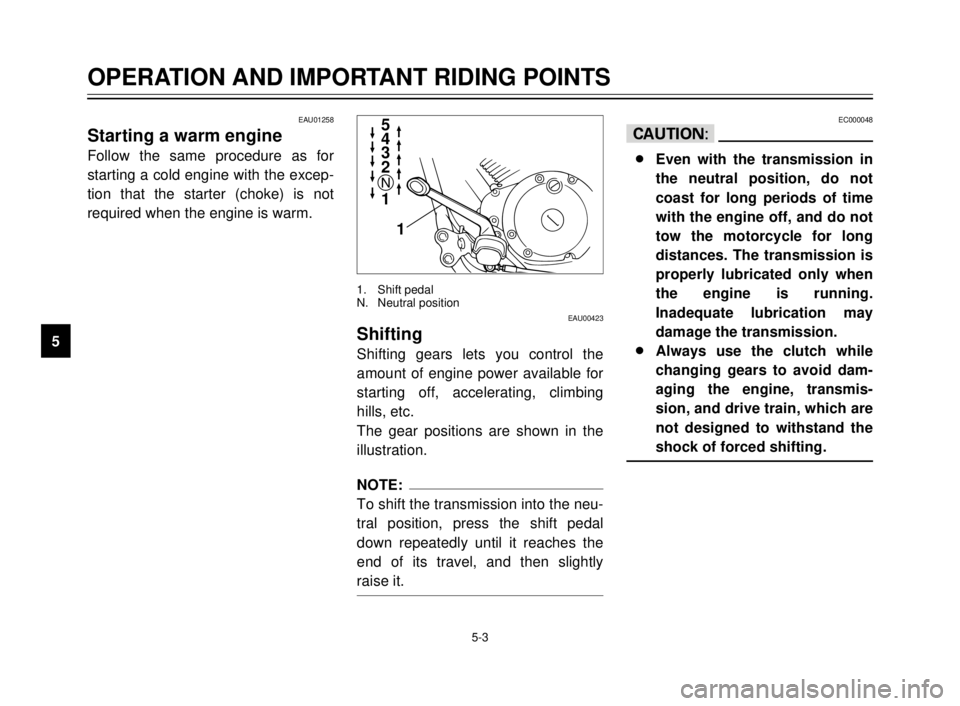
5-3
OPERATION AND IMPORTANT RIDING POINTS
1
2
3
4
5
6
7
8
9
EAU01258
Starting a warm engine
Follow the same procedure as for
starting a cold engine with the excep-
tion that the starter (choke) is not
required when the engine is warm.
1 N12 3 4 5
1
EAU00423
Shifting
Shifting gears lets you control the
amount of engine power available for
starting off, accelerating, climbing
hills, etc.
The gear positions are shown in the
illustration.
NOTE:
To shift the transmission into the neu-
tral position, press the shift pedal
down repeatedly until it reaches the
end of its travel, and then slightly
raise it.
1. Shift pedal
N. Neutral position
EC000048
cC
8Even with the transmission in
the neutral position, do not
coast for long periods of time
with the engine off, and do not
tow the motorcycle for long
distances. The transmission is
properly lubricated only when
the engine is running.
Inadequate lubrication may
damage the transmission.
8Always use the clutch while
changing gears to avoid dam-
aging the engine, transmis-
sion, and drive train, which are
not designed to withstand the
shock of forced shifting.
5JX-9-E0 4/9/0 4:11 AM Page 26
Page 29 of 86
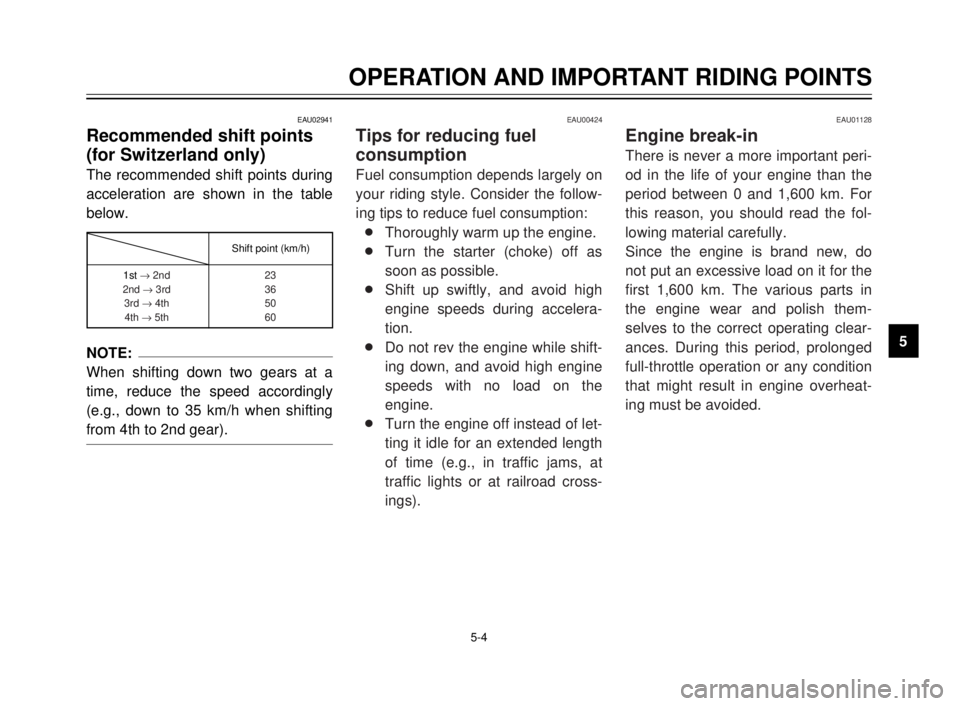
OPERATION AND IMPORTANT RIDING POINTS
1
2
3
4
5
6
7
8
9
5-4
EAU02941
Recommended shift points
(for Switzerland only)
The recommended shift points during
acceleration are shown in the table
below.
NOTE:
When shifting down two gears at a
time, reduce the speed accordingly
(e.g., down to 35 km/h when shifting
from 4th to 2nd gear).
Shift point (km/h)
1st ®2nd 23
2nd ®3rd 36
3rd ®4th 50
4th ®5th 60
EAU00424
Tips for reducing fuel
consumption
Fuel consumption depends largely on
your riding style. Consider the follow-
ing tips to reduce fuel consumption:
8Thoroughly warm up the engine.
8Turn the starter (choke) off as
soon as possible.
8Shift up swiftly, and avoid high
engine speeds during accelera-
tion.
8Do not rev the engine while shift-
ing down, and avoid high engine
speeds with no load on the
engine.
8Turn the engine off instead of let-
ting it idle for an extended length
of time (e.g., in traffic jams, at
traffic lights or at railroad cross-
ings).
EAU01128
Engine break-in
There is never a more important peri-
od in the life of your engine than the
period between 0 and 1,600 km. For
this reason, you should read the fol-
lowing material carefully.
Since the engine is brand new, do
not put an excessive load on it for the
first 1,600 km. The various parts in
the engine wear and polish them-
selves to the correct operating clear-
ances. During this period, prolonged
full-throttle operation or any condition
that might result in engine overheat-
ing must be avoided.
5JX-9-E0 4/9/0 4:11 AM Page 27
Page 30 of 86
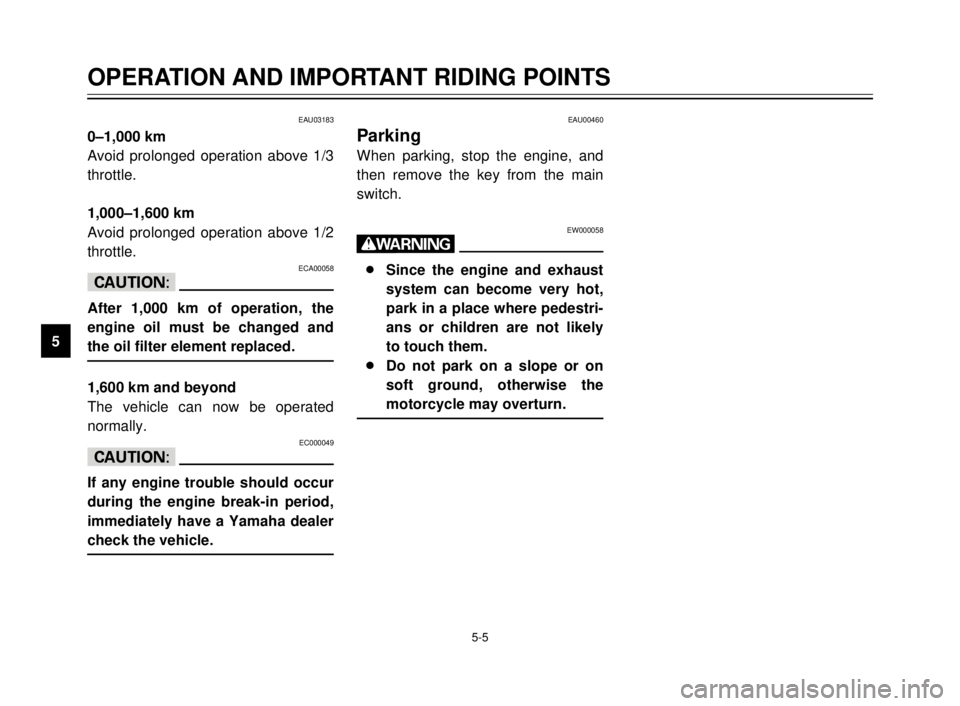
5-5
OPERATION AND IMPORTANT RIDING POINTS
1
2
3
4
5
6
7
8
9
EAU03183
0–1,000 km
Avoid prolonged operation above 1/3
throttle.
1,000–1,600 km
Avoid prolonged operation above 1/2
throttle.
ECA00058
cC
After 1,000 km of operation, the
engine oil must be changed and
the oil filter element replaced.
1,600 km and beyond
The vehicle can now be operated
normally.
EC000049
cC
If any engine trouble should occur
during the engine break-in period,
immediately have a Yamaha dealer
check the vehicle.
EAU00460
Parking
When parking, stop the engine, and
then remove the key from the main
switch.
EW000058
w
8Since the engine and exhaust
system can become very hot,
park in a place where pedestri-
ans or children are not likely
to touch them.
8Do not park on a slope or on
soft ground, otherwise the
motorcycle may overturn.
5JX-9-E0 4/9/0 4:11 AM Page 28